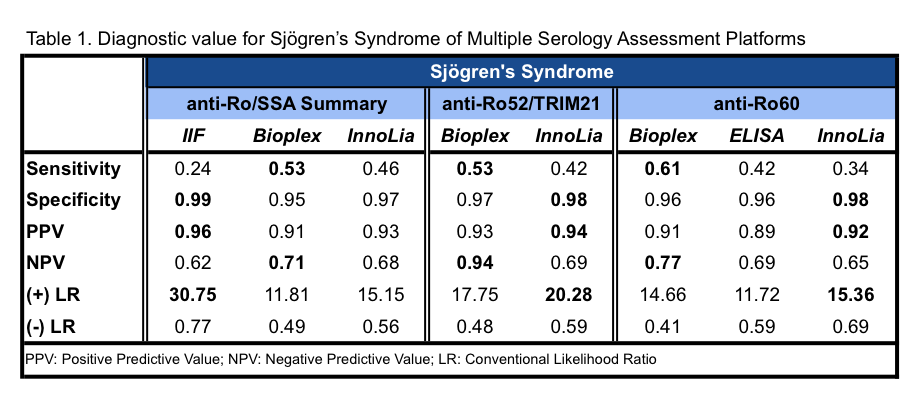Session Information
Session Type: ACR Poster Session A
Session Time: 9:00AM-11:00AM
Background/Purpose: The research classification and clinical diagnosis of SjšgrenÕs syndrome (SS) relies heavily on the detection of autoantibodies against Ro/SSA and La/SSB, particularly in the absence of salivary gland biopsy or when the histopathology of the minor salivary gland is normal. However, there is little consensus on the method or combination of methods that yield the best balance of sensitivity and specificity for SS.
Methods: We analyzed the results of multiple serology assessment platforms in 1530 subjects with SS or non-SS sicca evaluated at the OMRF SjšgrenÕs Research clinic. Our standard tests include ANA by indirect immunofluorescence on HEp-2 cells, Chrithidia luciliae for dsDNA, and double immunodiffusion (DID) for ENA. Anti-Ro/SSA and anti-La/SSB were determined by DID, a line assay (InnoLia ANA Update) and a bead-based assay (Bio-Rad BioPlex 2200) for anti-Ro52, Ro60 and La; and ELISA (Immunovision) for anti-Ro60. A subset of cases were also evaluated for anti-Ro52/TRIM21 by immunoprecipitation with human antigen and anti-La(+)/Ro(-) cases were confirmed by DID on HEp-2000 cells and RT-PCR.
Results: We observed significant differences in the performance of the tests in the same individuals. The concordance rate (kappa statistic) is detailed in Fig. 1. The most significant discrepancies were between DID and Bioplex and InnoLia; in almost all discordant cases, DID results were negative while they were positive for at least one of the other tests (anti-Ro 353/1318, 26.8%; anti-La 145/1253, 11.5%). InnoLia and Bioplex were highly concordant or Ro52 and are likely interchangeable; anti-Ro60 also showed high concordance across the three platforms tested but the minor discrepancies would result in the loss of 1.1% of positive subjects. Another clinically relevant finding was that in 1% of Ro52(+)/Ro60(+) cases total anti-Ro was negative, an artifact that has previously been reported. All tests and analytes showed excellent specificity for classification as primary SS, albeit at the expense of low sensitivity (Table 1).
Conclusion: The very low sensitivity of anti-Ro and anti-La DID in SS patients may result in misclassification of up to 25% of cases. Algorithms for a tiered approach for additional testing are necessary in the clinical setting to optimize diagnosis at a reasonable cost. For research, in particular clinical trials that require high specificity, all the tested platforms perform very well.
To cite this abstract in AMA style:
Rasmussen A, Grundahl K, Radfar L, Kaufman CE, Lewis DM, Segal BM, Rhodus NL, Bagavant H, Deshmukh U, Lessard CJ, Scofield RH, Sivils KL. Performance of Multiple Platforms for Autoantibody Testing in Sjogren’s Syndrome [abstract]. Arthritis Rheumatol. 2017; 69 (suppl 10). https://acrabstracts.org/abstract/performance-of-multiple-platforms-for-autoantibody-testing-in-sjogrens-syndrome/. Accessed .« Back to 2017 ACR/ARHP Annual Meeting
ACR Meeting Abstracts - https://acrabstracts.org/abstract/performance-of-multiple-platforms-for-autoantibody-testing-in-sjogrens-syndrome/


